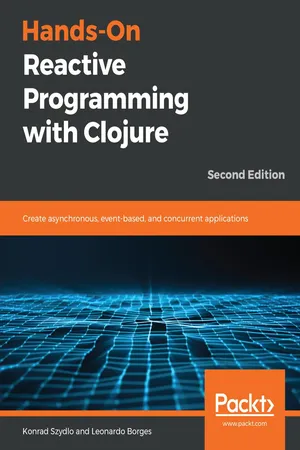
Hands-On Reactive Programming with Clojure
Create asynchronous, event-based, and concurrent applications, 2nd Edition
Konrad Szydlo, Leonardo Borges
- 298 pages
- English
- ePUB (mobile friendly)
- Available on iOS & Android
Hands-On Reactive Programming with Clojure
Create asynchronous, event-based, and concurrent applications, 2nd Edition
Konrad Szydlo, Leonardo Borges
About This Book
Learn how to use RxClojure to deal with stateful computations
Key Features
- Leverage the features of Functional Reactive Programming using Clojure
- Create dataflow-based systems that are the building blocks of Reactive Programming
- Use different Functional Reactive Programming frameworks, techniques, and patterns to solve real-world problems
Book Description
Reactive Programming is central to many concurrent systems, and can help make the process of developing highly concurrent, event-driven, and asynchronous applications simpler and less error-prone.
This book will allow you to explore Reactive Programming in Clojure 1.9 and help you get to grips with some of its new features such as transducers, reader conditionals, additional string functions, direct linking, and socket servers. Hands-On Reactive Programming with Clojure starts by introducing you to Functional Reactive Programming (FRP) and its formulations, as well as showing you how it inspired Compositional Event Systems (CES). It then guides you in understanding Reactive Programming as well as learning how to develop your ability to work with time-varying values thanks to examples of reactive applications implemented in different frameworks. You'll also gain insight into some interesting Reactive design patterns such as the simple component, circuit breaker, request-response, and multiple-master replication. Finally, the book introduces microservices-based architecture in Clojure and closes with examples of unit testing frameworks.
By the end of the book, you will have gained all the knowledge you need to create applications using different Reactive Programming approaches.
What you will learn
- Understand how to think in terms of time-varying values and event streams
- Create, compose, and transform observable sequences using Reactive extensions
- Build a CES framework from scratch using core.async as its foundation
- Develop a simple ClojureScript game using Reagi
- Integrate Om and RxJS in a web application
- Implement a reactive API in Amazon Web Services (AWS)
- Discover helpful approaches to backpressure and error handling
- Get to grips with futures and their applications
Who this book is for
If you're interested in using Reactive Programming to build asynchronous and concurrent applications, this is the book for you. Basic knowledge of Clojure programming is necessary to understand the concepts covered in this book.
Frequently asked questions
Information
The UI as a Function
- How React renders user interfaces efficiently
- An introduction to Om, a ClojureScript interface for React
- How Om leverages persistent data structures for performance
- Developing two fully working ClojureScript applications with Om, including the use of core.async for inter-component communication
The problem with complex web UIs
- Giving single-page applications more structure by providing models, views, controllers, templates, and so on
- Providing client-side routing
- Employing two-way data binding
function editContact(contactId) { contactService.get(contactId, function(data) { contactForm.setName(data.name); contactForm.setPhone(data.phone); contactForm.setEmail(data.email); }) } $("save-button").click(function(){ contactService.update(contactForm.serialize(), function(){ flashMessage.set("Contact Updated.") }) // JS // in the Controller $scope.contact = { name: 'Leonardo Borges', phone '+61 xxx xxx xxx', email: '[email protected]' } <!-- HTML --> <!-- in the View --> <form> <input type="text" name="contactName" ng-model="contact.name"/> <input type="text" name="contactPhone" ng-model="contact.phone"/> <input type="text" name="contactEmail" ng-model="contact.email"/> </form> - It can be slow. The way Angular and friends implement two-way data binding is, roughly speaking, by attaching event handlers and watchers to view both custom attributes and model attributes. For complex-enough user interfaces, you will start noticing that the UI becomes slower to render, diminishing user experience.
- It relies heavily on mutation. As functional programmers, we strive to limit side effects to a minimum.
document.getElementsByName("sum")[0].value = 1 + 2 // Operations per second: 2,090,202 1 + 2 // Operations per second: 780,538,120 Table of contents
- Title Page
- Copyright and Credits
- About Packt
- Contributors
- Preface
- What is Reactive Programming?
- A Look at Reactive Extensions
- Asynchronous Programming and Networking
- Introduction to core.async
- Creating Your Own CES Framework with core.async
- Building a Simple ClojureScript Game with Reagi
- The UI as a Function
- A New Approach to Futures
- A Reactive API to Amazon Web Services
- Reactive Microservices
- Testing Reactive Apps
- Concurrency Utilities in Clojure
- Appendix - The Algebra of Library Design
- Other Books You May Enjoy